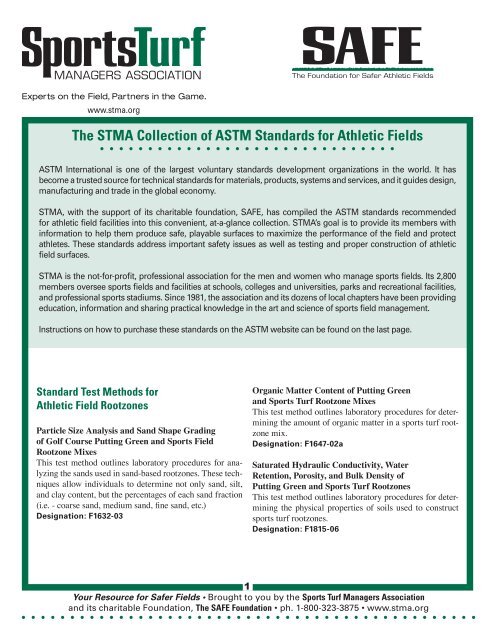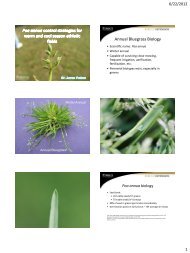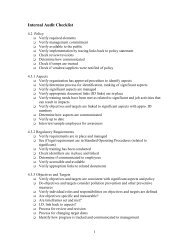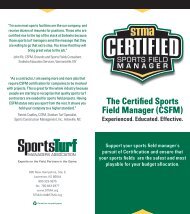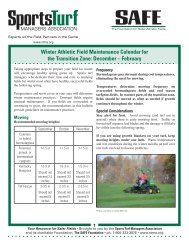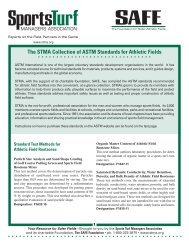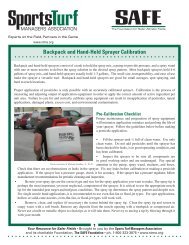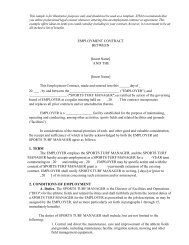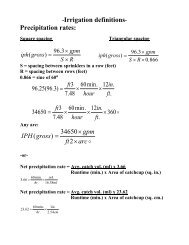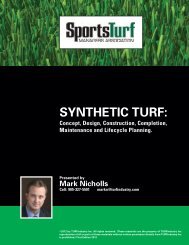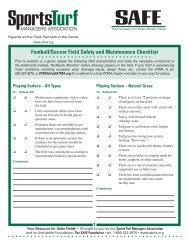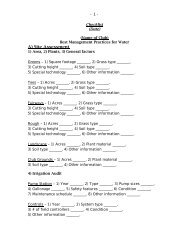The STMA Collection of ASTM Standards for Athletic Fields
The STMA Collection of ASTM Standards for Athletic Fields
The STMA Collection of ASTM Standards for Athletic Fields
You also want an ePaper? Increase the reach of your titles
YUMPU automatically turns print PDFs into web optimized ePapers that Google loves.
www.stma.org<br />
<strong>The</strong> <strong>STMA</strong> <strong>Collection</strong> <strong>of</strong> <strong>ASTM</strong> <strong>Standards</strong> <strong>for</strong> <strong>Athletic</strong> <strong>Fields</strong><br />
<strong>ASTM</strong> International is one <strong>of</strong> the largest voluntary standards development organizations in the world. It has<br />
become a trusted source <strong>for</strong> technical standards <strong>for</strong> materials, products, systems and services, and it guides design,<br />
manufacturing and trade in the global economy.<br />
<strong>STMA</strong>, with the support <strong>of</strong> its charitable foundation, SAFE, has compiled the <strong>ASTM</strong> standards recommended<br />
<strong>for</strong> athletic field facilities into this convenient, at-a-glance collection. <strong>STMA</strong>’s goal is to provide its members with<br />
in<strong>for</strong>mation to help them produce safe, playable surfaces to maximize the per<strong>for</strong>mance <strong>of</strong> the field and protect<br />
athletes. <strong>The</strong>se standards address important safety issues as well as testing and proper construction <strong>of</strong> athletic<br />
field surfaces.<br />
<strong>STMA</strong> is the not-<strong>for</strong>-pr<strong>of</strong>it, pr<strong>of</strong>essional association <strong>for</strong> the men and women who manage sports fields. Its 2,800<br />
members oversee sports fields and facilities at schools, colleges and universities, parks and recreational facilities,<br />
and pr<strong>of</strong>essional sports stadiums. Since 1981, the association and its dozens <strong>of</strong> local chapters have been providing<br />
education, in<strong>for</strong>mation and sharing practical knowledge in the art and science <strong>of</strong> sports field management.<br />
Instructions on how to purchase these standards on the <strong>ASTM</strong> website can be found on the last page.<br />
Standard Test Methods <strong>for</strong><br />
<strong>Athletic</strong> Field Rootzones<br />
Particle Size Analysis and Sand Shape Grading<br />
<strong>of</strong> Golf Course Putting Green and Sports Field<br />
Rootzone Mixes<br />
This test method outlines laboratory procedures <strong>for</strong> analyzing<br />
the sands used in sand-based rootzones. <strong>The</strong>se techniques<br />
allow individuals to determine not only sand, silt,<br />
and clay content, but the percentages <strong>of</strong> each sand fraction<br />
(i.e. - coarse sand, medium sand, fine sand, etc.)<br />
Designation: F1632-03<br />
Organic Matter Content <strong>of</strong> Putting Green<br />
and Sports Turf Rootzone Mixes<br />
This test method outlines laboratory procedures <strong>for</strong> determining<br />
the amount <strong>of</strong> organic matter in a sports turf rootzone<br />
mix.<br />
Designation: F1647-02a<br />
Saturated Hydraulic Conductivity, Water<br />
Retention, Porosity, and Bulk Density <strong>of</strong><br />
Putting Green and Sports Turf Rootzones<br />
This test method outlines laboratory procedures <strong>for</strong> determining<br />
the physical properties <strong>of</strong> soils used to construct<br />
sports turf rootzones.<br />
Designation: F1815-06<br />
1<br />
Your Resource <strong>for</strong> Safer <strong>Fields</strong> • Brought to you by the Sports Turf Managers Association<br />
and its charitable Foundation, <strong>The</strong> SAFE Foundation • ph. 1-800-323-3875 • www.stma.org
<strong>The</strong> <strong>STMA</strong> <strong>Collection</strong> <strong>of</strong> <strong>ASTM</strong> <strong>Standards</strong> <strong>for</strong> <strong>Athletic</strong> <strong>Fields</strong><br />
Standard Guides <strong>for</strong> <strong>Athletic</strong> Field<br />
Construction and Maintenance<br />
Quality Control Procedures During the<br />
Construction <strong>of</strong> Natural Playing Surfaces<br />
This proposed standard outlines proper practices to be<br />
used in the sampling and quality control testing <strong>of</strong> rootzone<br />
materials used during the construction process. <strong>The</strong><br />
standard covers gravel, sand, organic amendments, and<br />
finish-blended rootzone mixes<br />
Designation: WK490<br />
Construction <strong>of</strong> High Per<strong>for</strong>mance Sand-<br />
Based Rootzones <strong>for</strong> Sports <strong>Fields</strong><br />
This standard is to athletic fields what the USGA specifications<br />
are to golf course putting greens. <strong>The</strong> standard<br />
outlines techniques that are appropriate <strong>for</strong> the construction<br />
<strong>of</strong> sand-based sports turf rootzones. <strong>The</strong> standard<br />
provides guidance <strong>for</strong> the selection <strong>of</strong> materials including<br />
soil, sand, gravel, and peat, as well as an overview <strong>of</strong> appropriate<br />
design and construction practices.<br />
Designation: F2396-04<br />
Construction and Maintenance <strong>of</strong> Skinned<br />
Areas on Baseball and S<strong>of</strong>tball <strong>Fields</strong><br />
This standard covers techniques <strong>for</strong> constructing and maintaining<br />
skinned areas on baseball and s<strong>of</strong>tball fields. <strong>The</strong><br />
standard provides guidance <strong>for</strong> selecting suitable construction<br />
materials (soil, sand, etc.). Construction techniques are<br />
outlined along with minimum maintenance procedures such<br />
as scarification, irrigation, and the use <strong>of</strong> conditioners.<br />
Designation: F2107-07<br />
Construction and Maintenance <strong>of</strong> Warning<br />
Track Areas on Sports <strong>Fields</strong><br />
This standard covers techniques <strong>for</strong> constructing and<br />
maintaining warning track areas on sports fields. <strong>The</strong><br />
standard provides guidance <strong>for</strong> selecting suitable construction<br />
materials, as well as a list <strong>of</strong> suitable construction and<br />
maintenance techniques like edging, dragging, and rolling.<br />
Synthetic warning tracks are not covered in this standard.<br />
Designation: F2270-04<br />
Construction and Maintenance <strong>of</strong> Grass<br />
Tennis Courts<br />
This standard outlines techniques that are appropriate <strong>for</strong><br />
the construction and maintenance <strong>of</strong> grass tennis courts.<br />
<strong>The</strong> standard provides guidance <strong>for</strong> the selection <strong>of</strong> soil<br />
materials and turfgrass species to be used<br />
Designation: F1953-99(2003)<br />
Maintaining Cool Season Turfgrasses on <strong>Athletic</strong> <strong>Fields</strong><br />
This standard outlines the minimum requirements <strong>for</strong><br />
maintaining cool-season turfgrass athletic fields. Practices<br />
covered include mowing, fertilization, irrigation, core cultivation,<br />
and pest management.<br />
Designation: F2060-00(2005)<br />
Maintaining Warm Season Turfgrasses on <strong>Athletic</strong> <strong>Fields</strong><br />
This standard outlines the minimum requirements <strong>for</strong><br />
maintaining warm-season turfgrass athletic fields. Practices<br />
covered include mowing, fertilization, irrigation, core<br />
cultivation, winter overseeding, and pest management.<br />
Designation: F2269-03<br />
Standard Test Method <strong>for</strong> Playing Surfaces<br />
Measuring Shock-Attenuation Characteristics <strong>of</strong><br />
Natural Playing Surface Systems Using Lightweight<br />
Portable Apparatus<br />
This test method outlines procedures <strong>for</strong> measuring the<br />
hardness <strong>of</strong> athletic field playing surfaces with devices like<br />
the Clegg Soil Impact Tester.<br />
Designation: F1702-96(2002)e1<br />
Standard Test Method <strong>for</strong> Shock-Absorbing Properties<br />
<strong>of</strong> Playing Surface Systems and Materials<br />
This test method is applicable to both natural and artificial<br />
playing surface systems. Shock-absorbing characteristics,<br />
impact <strong>for</strong>ce-time relationships, and the rebound properties<br />
<strong>of</strong> playing surface systems are all measured.<br />
Designation: F355-01<br />
2<br />
Your Resource <strong>for</strong> Safer <strong>Fields</strong> • Brought to you by the Sports Turf Managers Association<br />
and its charitable Foundation, <strong>The</strong> SAFE Foundation • ph. 1-800-323-3875 • www.stma.org
<strong>The</strong> <strong>STMA</strong> <strong>Collection</strong> <strong>of</strong> <strong>ASTM</strong> <strong>Standards</strong> <strong>for</strong> <strong>Athletic</strong> <strong>Fields</strong><br />
Standard Specification <strong>for</strong> Shock-Absorbing<br />
Properties <strong>of</strong> North American Football Field Playing<br />
Systems as Measured in the Field<br />
This specification covers a test method and maximum<br />
impact attenuation <strong>for</strong> all types <strong>of</strong> installed turf playing<br />
systems <strong>for</strong> North American football. Areas within an existing<br />
playing system where shock-absorbing properties<br />
exceed recommended threshold values are identified using<br />
this specification. <strong>The</strong> turf playing system includes both<br />
inbounds and out-<strong>of</strong>-bounds areas where the athlete should<br />
expect compliant impact attenuation characteristics. It does<br />
not imply that an injury cannot be incurred if the surface<br />
system complies with this specification.<br />
Designation F1936-07e1<br />
Standard Guides <strong>for</strong> Soccer Goals<br />
Safety and Per<strong>for</strong>mance Specifications<br />
<strong>for</strong> Soccer Goals<br />
This standard outlines safety and per<strong>for</strong>mance requirements<br />
<strong>for</strong> soccer goals. Properties such as strength, stability,<br />
and weight are discussed.<br />
Designation: F2056-00<br />
Safer Use <strong>of</strong> Movable Soccer Goals<br />
This standard discusses how to install, use, and store soccer<br />
goals <strong>of</strong> various sizes.<br />
Designation: F1938-98(2004)<br />
Standard Guides <strong>for</strong> Synthetic Surfaces<br />
Measuring Lead (Pb) in Synthetic Turf Fibers and<br />
Finished Yarns<br />
This test method outlines the guidelines <strong>for</strong> reporting total<br />
lead content in the synthetic turf fibers. Turf fibers manufactured<br />
after September 1, 2009 qualify <strong>for</strong> this test.<br />
Designation: F2765-09<br />
Standard Test Method <strong>for</strong> Relative Abrasiveness<br />
<strong>of</strong> Synthetic Turf Playing Surfaces<br />
This test method measures the relative abrasiveness <strong>of</strong> fabric<br />
or carpet type synthetic playing surfaces.<br />
Designation: F1015-03(2009)<br />
Standard Test Methods <strong>for</strong> Comprehensive<br />
Characterization <strong>of</strong> Synthetic Turf Playing<br />
Surfaces and Materials<br />
<strong>The</strong>se test methods are used to identify physical property<br />
characteristics and comparison <strong>of</strong> the per<strong>for</strong>mance properties<br />
<strong>of</strong> synthetic turf systems or components <strong>for</strong> athletic<br />
and recreational uses, or both.<br />
Designation: F1551-09<br />
Standard Guides <strong>for</strong> Fences<br />
Fences on Ballfields and Other Sports Facilities<br />
This standard outlines minimum safety requirements <strong>for</strong><br />
various types <strong>of</strong> fences used on sports fields. Appropriate<br />
installation practices are discussed as well.<br />
Designation: F2000-06<br />
Construction <strong>of</strong> Chain-Link Tennis Court Fence<br />
This standard covers proper techniques <strong>for</strong> constructing<br />
chain-link fencing around tennis courts. Various types <strong>of</strong><br />
chain-link fabric and framework materials are discussed,<br />
in addition to appropriate installation procedures.<br />
Designation: F969-07<br />
Purchasing <strong>ASTM</strong> <strong>Standards</strong><br />
To purchase the <strong>ASTM</strong> standards, please visit the<br />
<strong>ASTM</strong> website (www.astm.org). By clicking on <strong>Standards</strong><br />
in the left hand column, you can then enter the<br />
Designation code listed above to view a summary<br />
and purchase the standard guides.<br />
3<br />
Your Resource <strong>for</strong> Safer <strong>Fields</strong> • Brought to you by the Sports Turf Managers Association<br />
and its charitable Foundation, <strong>The</strong> SAFE Foundation • ph. 1-800-323-3875 • www.stma.org


